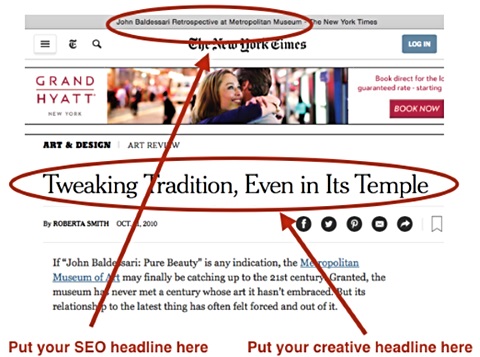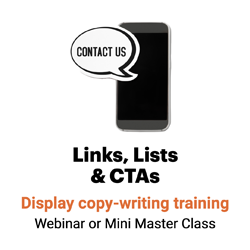Google never laughs; so must web heads be dull?
There’s a lot of sniveling and squawking going on in the web writing community these days. Consider the headlines:

- “This Boring Headline Is Written for Google,” grumble journalists.
- “Google doesn’t laugh,” moan headline writers.
- “Witty headlines: Black and white and dead all over,” kvetch communicators.
What’s all the bellyaching about? The fact that feature headlines don’t work so well online. Sad, but true: When it comes to web heads, it’s more important to optimize for search engines — and optimize for real people — than it is to be clever.
“Part of the craft of journalism for more than a century has been to think up clever titles and headlines,” writes Ed Canale, vice president for strategy and new media at The Sacramento Bee. “And Google comes along and says, ‘The heck with that.’”
“If there is a choice between boring and useless, I suggest going for boring.”
— Steffen Fjaervik, contributing writer for Poynter Online
Or, as Steffen Fjaervik, contributing writer for Poynter Online, suggests:
“If there is a choice between boring and useless, I suggest going for boring.”
But maybe those aren’t the only options.
Four ways to write creative headlines for the web
Here are three ways to work around the SEO and scanning restrictions of web heads:
1. Use your title tag and URL.
Your title tag gets more Google juice than your web headline. So put your literal headline in the title tag and put the feature headline on the content page. The New York Times, for instance, sometimes packs keywords into its title tags, but not into the page headline.

2. Use the deck.
You could also use the headline for the literal story, the deck for the creative or benefits-focused one.
- Literal headline: [Topic word] does what
- Benefits-oriented deck: You benefit how
- Creative deck: Clever wordplay or twist of phrase
3. Be witty and clear.
You’re brilliant, right? Why not write a headline that’s both creative and telling? The pros are pulling it off by writing:
a. A literal kicker with a clever headline. Corporate communicator Kevin Allen writes:
“Witty headlines: Black and white and dead all over”
b. A clever kicker with a literal headline. “a book review headline in The Guardian was topped with this headline:

And some smart editor at NPR wrote:

c. A topic word subject with a clever verb phrase. “A Wired copyeditor writes:

And a Kansas City Business Journal writer comes up with

4. A reversed mullet.
Put the business in the front, party in the back with headlines like this one, from CNN:

No, there’s no danger that readers will injure themselves in a laughing fit, but these writers do manage to make their headlines both literal and creative.
How to manage all of these headlines
So how do you handle content management with all of these headline options?
Ask the writers to provide headlines and other display copy or microntent and metadata with the stories. Writers understand the story best, after all, and this approach keeps the webmaster from frantically repurposing everything and the end of the process.
And if you are publishing and posting, include the print headline in the web metadata. Print readers will look up the story using the headline they saw in the publication.
Even if it’s not the headline you post on the content or index pages, they should be able to find what they’re looking for.
___
Sources: Andy Bechtel, “Writing Headlines for Digital and Mobile Media,” Poynter News University, Dec. 5, 2013
Kevin Allen, “Witty headlines: Black and white and dead all over (because of SEO),” Ragan’s PR Daily, May 13, 2011
Amy Gahran, “Smart Headlines: Beyond Shovelware,” PoynterOnline, March 3, 2011
Arthur S. Brisbane, “Glimpses of Online Journalism, From Inside and Out,” The New York Times, Dec. 25, 2010
“Writing Online Headlines: SEO and Beyond,” Poynter News University
Eric Ulken, “Writing Headlines for the web 2010,” Poynter University NewsU web course
Eric Ulken, “This headline not written for Google,” OJR: The Online Journalism Review, Oct. 20, 2009

These headline examples really help write a better headline! I never knew that using the deck could also be a great thing to use for your headlines to be better. Personally, I find that putting headline examples really helps with getting inspiration and finding areas in your headline where you can improve. What do you think?